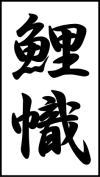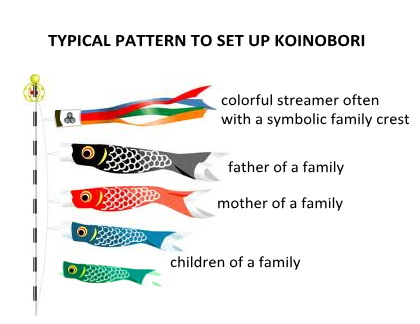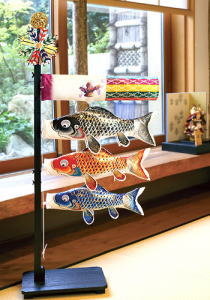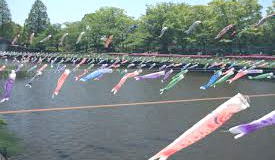


Samurai warrior dolls


Koinobori windsocks
| CURRENCY CONVERSION |
| All prices on this site are shown in Japanese currency Yen (JPY). Before
you place an order, please confirm the true value in your currency desired
by clicking below. |

THE NEWEST FOREIGN EXCHANGE RATE |
ANYTIME
OF A YEAR
.jpg)
|
In Japan, koinobori is a very seasonable item used only for the Children's
Festival, May 5th. Generally, you cannot buy koinobori at most of the shops
except in the last sales months, March and April, just before May 5th.
However, we always have enough stock through a year.
You can purchase anytime of a year. |
|
  KOINOBORI KOINOBORI
|
|
.jpg) |
 Koinobori, history and customs in Japan Koinobori, history and customs in Japan |
3.jpg) .jpg) Koinobori, carp windsocks, streamers or banners, decorate the landscape of Japan from April through early May, in honor of the Children's Day (originally the Boys' festival) on May 5. Koinobori, carp windsocks, streamers or banners, decorate the landscape of Japan from April through early May, in honor of the Children's Day (originally the Boys' festival) on May 5.
In Japanese culture, the carp symbolizes courage and strength because of its ability to swim up a waterfall.
The Boys' Festival was originally an event, expressing hope that each boy in the family will grow up healthy and strong like wild carps.
During this festival, people set up a warrior doll or a yoroi armor set in the house, and Koinobori, large carp-shaped windsocks, outside the house.
|
|
.jpg) |
| Banners used by samurai warriors on the battlefield |
.jpg)
Boys' Festival in the Edo era
.jpg)
"Suidobashi-Surugadai"
painted by Utagawa Hiroshige |
 The Japaneae word "Koinobori" is a conbination of 2 original words, koi and nobori. "Koi" means a carp and "Nobori" means a banner or flag. The Japaneae word "Koinobori" is a conbination of 2 original words, koi and nobori. "Koi" means a carp and "Nobori" means a banner or flag.
Originally, the banners, flags or windsocks were used by samurai warriors
on the battlefield. Whenever the ancient warriors were on the battlefield,
they wore full yoroi armors and flew banners (See above).
These banners were painted in various colors and shapes. Some of them had carp pictures on them. They became "carp banners" at the beginning of the Edo era (1603 – 1868).
Since the carp's courage and strength is a trait desired in boys, families traditionally have flown koinobori from their homes to honor their sons.
koinobori in the Edo-era were all black like wild carps, no other colors, as can be seen in Utagawa Hiroshige's ukiyo-e (See the left).
When in the Meiji-era (1868 – 1912), with the rapid Westernization called
"Bunmei-kaika", koinobori in red and some other colors have appered.
Through the gradual change of many years through the Meiji, Taisho (1912–1926)
and Showa (1926-1989) era, colorful koinobori culture with the following
setting-up pattern has been established all over Japan. |
 A typical koinobori set established in the Showa-era consists of, from the top of the pole down, a pair of arrow-spoked wheels (yaguruma) with a ball-shaped spinning vane, top streamer (fukinagashi) that looks like a windsock, a black koinobori and a red koinobori. If more children are in the household, an additional blue, green and then purple or orange koinobori are added. A typical koinobori set established in the Showa-era consists of, from the top of the pole down, a pair of arrow-spoked wheels (yaguruma) with a ball-shaped spinning vane, top streamer (fukinagashi) that looks like a windsock, a black koinobori and a red koinobori. If more children are in the household, an additional blue, green and then purple or orange koinobori are added.
These carp sets are flown above the roofs of houses, with the biggest black koinobori for the father, next biggest red for the mother, and ranging down to the smallest carp for the youngest child. |

Indoor koinobori set |
Recently for these 3 decades in the Heisei era (1989-2019), the above custom
of koinobori has considerably changed.
.jpg)
First of all, this change is very remarkable in its size. The big set of
koinobori seldom can be seen now in Japan especially in the urban area.
This is because most of the ordinary families don't have enough broad space
for setting-up the large koinobori. For example, there are a lot of apartments/condominiums
which prohibit setting-up koinobori in each balcony in the urban area such
as Tokyo. Thus the smaller set of koinobori or indoor koinobori have become
preferred now in Japan. |
 Secondly, the big change has occured in its way of setting-up. Traditionally, Koinobori has been set-up vertically with a very tall pole like the above typical pattern. However, the new horizontal way of setting-up of koinobori has become popular year by year, especially in the big events such as the festivals held in many cities all over Japan. This horizotal way of setting-up koinobori can be seen everywhere, in the valleys, over the rivers/ponds/lakes etc. (See the right.) Secondly, the big change has occured in its way of setting-up. Traditionally, Koinobori has been set-up vertically with a very tall pole like the above typical pattern. However, the new horizontal way of setting-up of koinobori has become popular year by year, especially in the big events such as the festivals held in many cities all over Japan. This horizotal way of setting-up koinobori can be seen everywhere, in the valleys, over the rivers/ponds/lakes etc. (See the right.)
In this way, the unique koinobori culture in Japan is still continuing to evolve by changing in many aspects. |
.jpg) |
| Koinobori with Mt. Fuji on the background |
|
|
|



